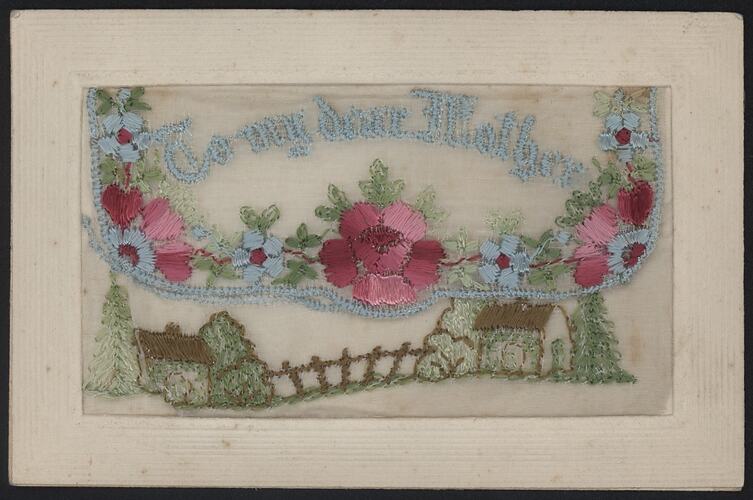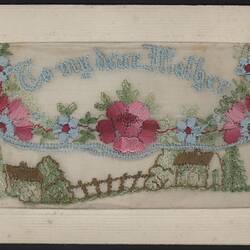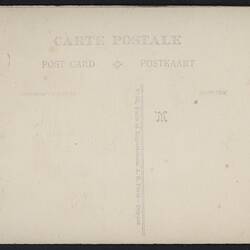Summary
Embroidered postcard with muslin flap, inscribed 'To My Dear Mother'. As this postcard remains blank it is not known whether it was sent home uninscribed or whether it was brought home unused.
According to the Australian War Memorial, the popularity of embroidered postcards (first made for the Paris Exposition in 1900) peaked during World War I. Many were 'embroidered by French women in their homes and then sent to the factories for cutting and mounting on postcards'. Common themes included family, remembrance, liberty, unity and war souvenirs.
Description of Content
Pink and blue flowers with surrounding leaves along the edge of upper piece of muslin. Blue inscription in between the flowers. Lower piece displays two green and brown cottages with surrounding trees and a path from one cottage to the other.
Physical Description
A cardboard postcard with two pieces of muslin with blue lining attached to the top and bottom of corrugated cardboard border. Colourful images and text sewn onto muslin; top piece opens upwards. The back of the postcard displays printed text with a dividing-back.
Significance
Embroidered postcards were very popular during World War I, with common themes including family, remembrance, liberty and unity. Their popularity began to wane after the war and they are not found after c.1923, making embroidered postcards a souvenir unique to World War I.
More Information
-
Collecting Areas
-
Acquisition Information
Purchase
-
Place & Date Made
-
Format
Postcard
-
Inscriptions
Embroidered in blue cursive text on the front of the postcard: 'To my dear mother' Printed in purple ink on the back of the postcard in the centre: 'CARTE POSTALE / POST CARD ; POSTKAART / CORRESPONDANCE ; ADDRESS' Printed in purple ink along the centre dividing line on the back of the postcard: 'VISÉ, Paris et Exportation. J.S. PARIS. déposé'.
-
Classification
-
Category
-
Discipline
-
Type of item
-
Overall Dimensions
139 mm (Width), 90 mm (Height)
-
Keywords
Embroidery, Postcards, Souvenirs, Families, World War I, 1914-1918


